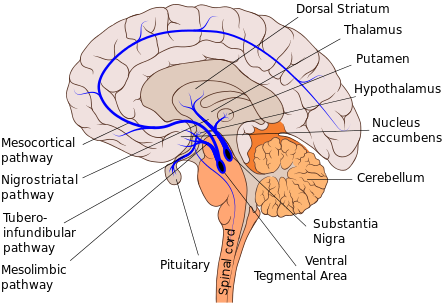Balanced Dopamine Can Maximize Your Life
Dopamine is a well-known neurotransmitter and an important topic to understand. There are different neurotransmitters within the brain and they all have different functions they carry out. Dopamine acts as a reward system in the brain and when there is a release, it makes a person feel great after achieving some task (or some experience). Dopamine is also linked to learning, attention, and motivation the chemical is one of the major neuromodulators which means neurons communicate with each other to regulate with other neurons. This expands throughout the forebrain and this is responsible for sensory processing. The body and brain are always adapting to anything new. Sensory processing records stimuli with which the person interacts with anything that is involved with the 5 senses. Based on the interaction the brain will process the information to develop a behavioral or physical response.
People can get a dopamine surge in many various ways. It is common to get it from consuming substances or getting involved in activities that will give you a surge. However, people tend to expose themselves to unhealthy habits or ingest products that can cause a negative impact. Some of these practices can lead to addiction because of the overproduction of dopamine-releasing. What the person is doing or ingesting makes them feel ecstatic the individual continues to crave what triggered dopamine release. Examples like gambling or consuming junk food result in addiction. But there are drawbacks with too much dopamine dispensed. The primary issue would be having less control which leads to impulsive actions and anhedonia (which is something stress-related that can affect the sense of finding pleasure in activities).
Why is this Important?
Neurotransmitters are important because the neurons are communicating from the brain to the body. Without them, the body will not function as expected. Dopamine appears to be crucial as it is responsible for brain states, vigilance, action, reward, learning, and memory. Without a balance of dopamine, it can have negative effects on the individual such as depression, schizophrenia, and other brain diseases. There are other neurotransmitters that get released like GABA and noradrenaline which have a close relationship with dopamine.
There is also a linkage between dopamine and the gut since the gut and brain are well-connected. It could be possible that the dopamine in the gut is vital to a variety of physiological processes that may directly or indirectly impact neurotransmission. But the contents of dopamine are obviously higher in the brain. Surely enough the foods consumed are broken down and have compounds like phenylalanine (precursor to dopamine). However, the microorganism in the gut (gut bacteria) may synthesize or degrade these compounds. In other words, not all of the tyrosine or phenylalanine will be used from the consumed foods. So it appears that gut health is crucial for supporting brain health (it has always been, 😊).
If you are interested in learning and improving brain health check out these!
The Process Of the Release
Dopamine is produced from the ventral tegmental area (VTA) and substantia nigra pars compacta which are located in the center of the brain. Dopamine is derived from an amino acid called tyrosine, phenylalanine, and L-dopa these components are what help create dopamine. As mentioned before biological processes initiate once the individual has exposure within their surroundings (stimuli). Based on every interaction the brain will remember the experience. Dopamine release is fast and spreads throughout the brain. There are different pathways where dopamine travels through. The 3 pathways are:
- Nigrostriatal (where it begins and dorsal striatum): This stems off the midbrain and is responsible for movement like motor function.
- Mesolimbic (ventral striatum): This also stems from the midbrain and it is responsible for pleasure, addiction, and feelings.
- Mesocortical: Located in the midbrain as well and known for the process of learning and behavior.

These pathways are vital as they can be affected by brain disorders including Parkinson’s disease, schizophrenia, and addiction.
The transportation of cells in the body goes through many processes as which is called exocytosis and along with this are active zone that are important for dopamine transmission. The volume and amount of dopamine can vary how fast and how much is being coded in the brain. In most cases, the discharge of dopamine axons elicits dopamine release with speedy kinetics. When the release occurs it activates the dopamine receptors with a signaling speed of tens of milliseconds.

What Could be Done?
There are natural ways to raise and balance out dopamine levels. It is always best to take the natural approach since there are little to no side effects. Keep in mind that just because there are drawbacks to the overproduction of dopamine that does not mean we cannot live without it. There are also disadvantages of low levels of dopamine. Like many other biological entities in the body and brain, it is essential for all to be active as it supports the individual’s overall health. But balance is the major factor in well-being so there are practices to incorporate. Best to do what is beneficial and to maintain a healthy balance.
Some things to consider doing:
- Meditation
- Exercise
- Spend time in nature
- Balanced diet (Consider protein-rich and gut-healthy food in your diet)
- Get quality rest (sleep)
Some things to avoid:
- Media – T.V., smartphones, anything with a screen. (At the very least limit your time with them).
- Highly processed foods.
- Gambling.
- Smoking.
Like many activities or anything in general it is all habitual since people are creatures of habit. Certain actions are expected to be done by the individual (Ex. They do the same actions daily like consistently browsing social media) but only the person is committing them. There also can be instances where if a person’s expectations (reward or something great happening) were exceeded there can be a strong release of dopamine. The striatal cholinergic interneurons are sourcing the signal.
Conclusion
Dopamine is responsible for the essential functions of people’s brains and bodies. This helps many with gaining motivation, learning, attention, memory, and well-being. More importantly, it can impact physical and brain health. With little or too much levels of dopamine in the system there could be a feeling of restlessness, addiction, or other negative effects. Having a balanced biochemistry is all that keeps people aware and healthy. The understanding of how dopamine functions can be complex as it varies on the volume, speed, and where it is being signaled from. What is imperative is living a natural life and avoiding overstimulation since this is what can cause a surge (too much) of dopamine.
If you found this post helpful please consider sharing and subscribing! 😃






